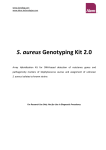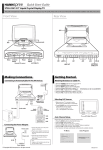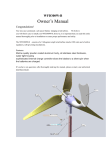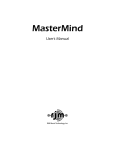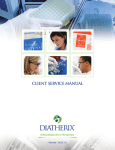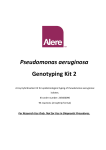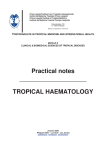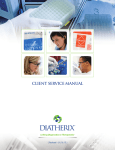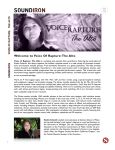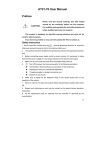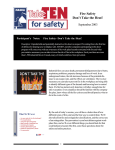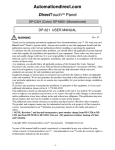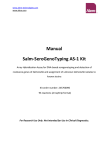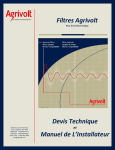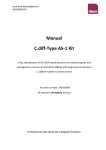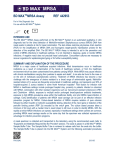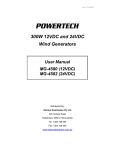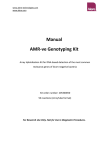Download identibac S. aureus Genotyping Kit
Transcript
www.clondiag.com www.alere-technologies.com identibac S. aureus Genotyping Kit Array Hybridisation Kit for DNA-based detection of resistance genes and pathogenicity markers of Staphylococcus aureus and assignment of unknown S. aureus isolates to known strains For Research Use Only. Not for Use in Diagnostic Procedures. www.clondiag.com www.alere-technologies.com CONTENT BACKGROUND ................................................................................................................................. 1 GENERAL INSTRUCTIONS FOR USE .................................................................................................. 2 Intended Use ................................................................................................................................ 2 Specifications ............................................................................................................................... 2 Technical Support ........................................................................................................................ 2 Safety Precautions ....................................................................................................................... 3 Material Safety Data Sheets (MSDS)............................................................................................ 3 Shipping Precautions.................................................................................................................... 3 REAGENTS AND DEVICES ................................................................................................................. 4 Kit Components, Storage and Stability ........................................................................................ 4 Cell Lysis .................................................................................................................................... 4 DNA Labelling and Amplification .............................................................................................. 4 Hybridisation and Detection..................................................................................................... 5 Instrumentation & Software ........................................................................................................ 5 Components Required but not Provided ..................................................................................... 6 PROTOCOL ....................................................................................................................................... 8 Culturing and Harvesting Bacterial Cells ...................................................................................... 8 Extraction of DNA......................................................................................................................... 8 Extraction of DNA by Spin Columns.......................................................................................... 9 Extraction of DNA by Automated Device ............................................................................... 11 Linear Amplification and Internal Biotin Labelling..................................................................... 11 Hybridisation .............................................................................................................................. 12 General Remarks - Handling of Arrays ................................................................................... 12 General Remarks - Handling of Liquids .................................................................................. 13 General Remarks – the Substrate (Precipitating Dye) D1 ...................................................... 14 General Remarks - Thermoshakers ........................................................................................ 14 Protocol for Quantifoil’s BioShake iQ ..................................................................................... 14 Adapted Protocol for Eppendorf’s Thermomixer Comfort .................................................... 16 Data Analysis .............................................................................................................................. 17 Starting the ArrayMate Reader .............................................................................................. 17 Worklist................................................................................................................................... 18 Data Acquisition in the ArrayMate Reader ............................................................................ 20 Results..................................................................................................................................... 22 Export of S. aureus Genotyping Test Reports......................................................................... 23 S. aureus Genotyping Kit 05-16-04-001-V05_Manual_S. aureus.pdf www.clondiag.com www.alere-technologies.com TROUBLESHOOTING ...................................................................................................................... 26 Staining Control.......................................................................................................................... 26 Image Quality ............................................................................................................................. 26 DNA Quality................................................................................................................................ 27 Physical Damage to the Array .................................................................................................... 27 Ambiguous Results ..................................................................................................................... 27 Report Unavailable..................................................................................................................... 28 Error Messages in Result Sheets ................................................................................................ 28 ADDITIONAL INFORMATION ......................................................................................................... 30 Warranty .................................................................................................................................... 30 Disclaimer................................................................................................................................... 30 Quality Control ........................................................................................................................... 31 List of Components for Separate Order ..................................................................................... 31 Legal Manufacturer .................................................................................................................... 31 Contact ....................................................................................................................................... 31 LITERATURE ................................................................................................................................... 32 UPDATES & SOFTWARE ................................................................................................................. 32 APPENDIX 1 - FLOW CHART ........................................................................................................... 33 APPENDIX 2 – IMAGES FOR TROUBLESHOOTING ......................................................................... 35 APPENDIX 3 – TARGET GENES ....................................................................................................... 36 APPENDIX 4 – TYPING INFORMATION .......................................................................................... 44 Definitions & Explanations ......................................................................................................... 44 List of Currently Recognised Strains .......................................................................................... 45 S. aureus Genotyping Kit 05-16-04-001-V05_Manual_S. aureus.pdf www.clondiag.com www.alere-technologies.com BACKGROUND The CLONDIAG S. aureus Genotyping allows DNA-based detection of resistance genes and pathogenicity markers of Staphylococcus aureus and assignment of unknown S. aureus isolates to known strains. RNA-free, unfragmented genomic DNA from pure and monoclonal S. aureus colony material is amplified approximately 40-fold and internally labelled with biotin-dUTP using a linear amplification protocol. In contrast to standard PCR, only one antisense primer per target is used resulting in producing single stranded (ss) DNA reaction products. This allows a simultaneous sequence specific labelling and amplification of an essentially unlimited number of targets. However, sensitivity is lower than in a standard PCR (whereas contamination with amplicons is nearly impossible) and for that reason the method is restricted to colony material and cannot be performed on samples such as swabs or pus. Resulting biotin labelled ssDNA is transferred and hybridised to DNA oligonucleotide microarrays with 333 probes for different genetic markers and a biotin staining control. These probes are printed in two spots each. The target set consists of a variety of species markers, virulence-associated genes including genes that code for exotoxins, antibiotic resistance genes, genes encoding microbial surface components recognizing adhesive matrix molecules (MSCRAMMs), various enzymes and other types of markers [1]. Spot recognition is performed automatically based on a digital image of the arrays. The overall pattern is analysed automatically for the presence or absence of specific genes and it is compared to a database of strain profiles allowing assignment to clonal complexes and strains [1, 2]. S. aureus Genotyping Kit 05-16-04-001-V05_Manual_S. aureus.pdf 1 www.clondiag.com www.alere-technologies.com GENERAL INSTRUCTIONS FOR USE Intended Use For Research Use Only. Not Intended for Use in Clinical Diagnostics. This kit allows genotypic characterisation of S. aureus isolates for research and epidemiological applications. It must not be used as a substitute for phenotypic susceptibility tests and for the guidance of antibiotic therapy. It cannot be used for other bacteria than S. aureus. Specifications Upon receipt, the assay components need to be stored at different temperatures as specified on the package insert. The assay is to be performed at an ambient temperature of 18°C to 28°C. Technical Support If you require any further information on this product please contact: email: [email protected] phone: +49 (0) 3641 3111 0 S. aureus Genotyping Kit 05-16-04-001-V05_Manual_S. aureus.pdf 2 www.clondiag.com www.alere-technologies.com Safety Precautions The kit is intended for use by personnel that are trained in microbiological and molecular methods. Preparation of DNA from pure S. aureus colonies (clones) requires expertise in microbiology and the local regulations for handling of pathogenic microorganisms (biosafety level 2) are to be obeyed. Isolated, cell-free S. aureus DNA may be processed without further biosafety precautions, although contamination with S. aureus or other bacteria needs to be ruled out. Always wear protective clothes as required for laboratory work by your local regulations. Material Safety Data Sheets (MSDS) According to OSHA 29CFR1910.1200, Commonwealth of Australia [NOHSC: 1005, 1008(1999)] and the latest amendments to the European Union Directives 67/548/EC and 1999/45/EC, the enclosed reagents do not require a Material Safety Data Sheet (MSDS). They do not contain more than 1% of a component classified as hazardous and do not contain more than 0.1% of a component classified as carcinogenic. MSDS therefore are not provided. Nevertheless, the buffers may cause irritation if they come into contact with eyes or skin, and may cause harm if swallowed. The regular precautions associated with laboratory work should be obeyed (e.g., wear protective goggles, gloves and lab coat and avoid contact with the reagents). In case, any liquids are spilled, clean with disinfectant and/or laboratory detergent and water. Alere assumes no liability for damage resulting from handling or contact with these products. If you have any questions please contact our Technical Support (see above). Shipping Precautions RID/ADR: Kein Gefahrgut / No dangerous goods IMDG: No dangerous goods IATA: No dangerous goods S. aureus Genotyping Kit 05-16-04-001-V05_Manual_S. aureus.pdf 3 www.clondiag.com www.alere-technologies.com REAGENTS AND DEVICES Kit Components, Storage and Stability All reagents are provided in a certain surplus amount (see below). In case of need, all components may also be ordered separately; please refer to the order numbers at the end of this manual. For pricing please contact your local representative or our customer service, respectively. The expiry date can be found on each bottle and on the outer package. All components have been tested for stability for short term shipment (<1 week) at ambient temperature (< 37 °C). The kit components with a rather limited stability are D1 and C3. The other components have proven to be stable even six months after the kit expiry date has passed. Cell Lysis • A1: Lysis Buffer Store at 18-28°C (ambient temperature). Surplus: 50%. • A2: Lysis Enhancer (lyophilised) Store at 18-28°C (ambient temperature). Centrifuge A2 tubes shortly prior to opening. Add 200 µL Buffer A1 to Lysis Enhancer before use. Mix well and store for less than 1 week at 28°C. Sufficient for 96 isolations. DNA Labelling and Amplification • B1ST: Labelling Buffer/Master Mix Store at 2-8°C. Surplus: 25%. • B2: Labelling Enzyme Store at 2-8°C. Surplus: 50%. S. aureus Genotyping Kit 05-16-04-001-V05_Manual_S. aureus.pdf 4 www.clondiag.com www.alere-technologies.com Hybridisation and Detection • ArrayStrips (12 x 8 samples), Protected against light and sealed under inert gas. Store at 18°C to 28°C. After opening to be used within two weeks. Close the unused wells with caps, protect them against humidity and dust and store them at a dark place. Avoid any touching or scratching of the surface of the microarray at the bottom of the well. Do not store or handle unused wells at an air humidity of more than 60% since this may irreversibly corrode the spots. • CapStrips (24 strips) • C1: Hybridisation Buffer Store at 18-28 °C, protect against sunlight. Surplus: 100%. • C2: Washing Buffer 1 Store at 18 °C - 28 °C, protect against direct sunlight. Surplus: 100%. • C3: HRP Conjugate 100x Store at 2-8 °C, protect against direct sunlight. Surplus: 100%. • C4: Conjugate Buffer Store at 18°C to 28°C, protect against direct sunlight. Surplus: 200%. • C5: Washing Buffer 2 Store at 18°C to 28°C, protect against direct sunlight. Surplus: 200%. • D1: Horseradish Peroxidase Substrate Store at 2-8°C, protect against direct sunlight. Surplus: 50%. • CM: Reference DNA from S. aureus strain N315 (GenBank accession number BA000018), 0.1 µg/µL. Store at 2-8 °C. Sufficient for 5-6 tests. Instrumentation & Software • ArrayMate Reader (to be ordered separately, for details see below) The S. aureus Genotyping kit may be used on the ArrayMate reader only. The older devices S. aureus Genotyping Kit 05-16-04-001-V05_Manual_S. aureus.pdf 5 www.clondiag.com www.alere-technologies.com ATR01/03 are not suitable for reading ArrayStrip based assays. In case of any questions please contact your local distributor and/or Alere Jena. • Iconoclust software (provided with the reader) • Test specific software plug-in that contains information such as spot names, marker names, location of the spots on the array. This plug-in is delivered with the reader or can be downloaded from our website. Test-specific plug-ins will occasionally be updated. Please check the NEWS section of our website http://www.clondiag.com. Support is available under [email protected] or +49 (0) 3641 3111 0. Components Required but not Provided • Growth media for the cultivation of S. aureus. The test should be performed with colonies harvested from Columbia Blood Agar. Other media that contain blood may also suffice, but have not systematically been tested. Media that do not contain blood (Mueller-Hinton, or MRSA selective media) usually yield lower DNA concentrations and should not be used. Liquid media should also not been used because contaminations or mixed cultures cannot easily be ruled out. • Equipment and consumables needed for the cultivation of S. aureus (incubator, inoculation loops, Petri dishes) • Clumping factor/coagulase assays for confirmation of S. aureus • DNA preparation kit: The assay has been tested with the DNeasy Blood & Tissue Kit from Qiagen (cat# 69504), QIAamp Minikit (cat# 51306) and a DNA preparation kit for Qiagen´s EZ1 automated device (DNA Tissue Kit, cat# 953034). Please note: DNA isolation from S. aureus requires a pre-treatment with the Cell Lysis components A1/A2 (see below). • Equipment needed for DNA isolation, e.g. pipettes, centrifuge, thermoshaker or automated device (see above) • Photometer for measuring the concentration of DNA S. aureus Genotyping Kit 05-16-04-001-V05_Manual_S. aureus.pdf 6 www.clondiag.com www.alere-technologies.com • Equipment for DNA gel electrophoresis for quality control of DNA • Thermocycler • Thermoshaker We strongly recommend the BioShake iQ by Quantifoil Instruments (http://www.qinstruments.com/) equipped with a customised heating block designed to fit ArrayStrips. Alternatively, you may use Eppendorf’s Thermomixer Comfort, equipped a heating block for microtitre plates. • Pipettes: suitable for 1µL-5µL volumes, 90µL, 100µL, 200µL, 1000µL • Multichannel Pipettes for 100-200 µL • Reagent tubes suitable for PCR • Ultrapure (PCR grade) water S. aureus Genotyping Kit 05-16-04-001-V05_Manual_S. aureus.pdf 7 www.clondiag.com www.alere-technologies.com PROTOCOL Culturing and Harvesting Bacterial Cells S. aureus is a potential pathogen. All procedures for cultivation of the bacterium and DNA preparation need to be performed by properly trained staff in a biosafety level 2 facility. Grow S. aureus on Colombia blood agar (overnight at 37°C or 48 hrs at room temperature). Obtain confirmation of the identification as S. aureus (by katalase + coagulase/clumping factor assays or by other means) and make sure that you have a pure, monoclonal culture of S. aureus. Contamination with other bacteria, especially with other staphylococci needs to be strictly avoided as the might carry the same resistance genes as certain S. aureus strains and thus can introduce false positive signals and patterns. • Centrifuge A2 tube shortly, open it, add 0.2 mL of Lysis Buffer A1 to Lysis Enhancer A2 and dissolve. • Add an inoculating loop full of monoclonal colony material of the S. aureus isolate to this A1/A2 reagent, vortex. Loop empty Loop full It is important to harvest enough bacteria; this is a prerequisite for extraction of a sufficient amount of DNA. Take an inoculating loop of 1mm diameter filled with bacteria as shown in the right picture. Extraction of DNA The required sample type for the S. aureus Genotyping assay is 0.5-2 µg of intact genomic DNA from a single clone of S. aureus. S. aureus Genotyping Kit 05-16-04-001-V05_Manual_S. aureus.pdf 8 www.clondiag.com www.alere-technologies.com This is much more DNA than for standard PCR applications (see Introduction). The DNA specimen needs to be free of RNA and it should not be fragmented. This can be determined by agarose gel electrophoresis. DNA should not be prepared by disrupting S. aureus cells using bead beaters, ultrasonication or aggressive chemicals such as in alkaline lysis protocols. Most performance problems with the S. aureus Genotyping kit are due to insufficient amounts or quality of DNA preparation. We therefore strongly recommend following the protocols outlined below. We also recommend performing an experiment with Reference DNA from S. aureus strain N315 (CM reagent) when establishing the procedure in your lab. This will help to determine the cause of possible problems. Extraction of DNA by Spin Columns • Incubate the colony material of the S. aureus isolate in A1/A2 for 30-60 min at 37°C and 550 rpm in the thermoshaker. • Proceed with the DNA preparation protocol of the DNA preparation kit. For the Qiagen DNeasy Blood&Tissue Kit that is as follows: • Add 25 µL proteinase K (Qiagen Kit, or equivalent) and add 200 µL buffer AL (Qiagen Kit) • Vortex shortly or shake vigorously. • Incubate for 30-60 min at 56°C and 550 rpm in the thermoshaker. • Add 200 µl ethanol (96-100%). • Vortex the sample and centrifuge shortly. • Transfer the complete content of the tube (including any precipitate) into a spin column that is placed in a 2 ml collection tube. • Centrifuge at room temperature, time and speed need to be determined depending on viscosity of the sample and type of centrifuge used. All liquid should be collected in the collection tube afterwards. • Discard collection tube with liquids. S. aureus Genotyping Kit 05-16-04-001-V05_Manual_S. aureus.pdf 9 www.clondiag.com www.alere-technologies.com • Place the spin column in a new 2 ml collection tube (provided with the kit). • Add 500 µl Buffer AW1. • Centrifuge at room temperature. • Discard collection tube with liquids. • Place the spin column in a new 2 ml collection tube (provided with the kit). • Add 500 µl Buffer AW2. • Centrifuge at room temperature, the membrane of the spin column should be dry, and all liquid should be in the collection tube. • Discard collection tube with liquids. • Place the spin column in a clean 1.5 ml tube (provided with the kit). • Add 50 µl Buffer AE (or PCR grade distilled water) directly onto the membrane of the spin column. • Incubate at room temperature for 5 min to elute DNA. • Centrifuge. • Optional: add another 50 µl Buffer AE (or PCR grade distilled water) directly onto the membrane, incubate at room temperature for 1 min and centrifuge again. • Discard the spin column. Ethanol from Washing Buffers strongly inhibits the enzymes used in the assay. A contamination with Washing Buffer might occur during elution of prepared DNA by drops adhering to the funnel of the spin columns. Thus these funnels should be gently touched and tried with sterile filter paper or wipes prior to the elution step. Alternatively, prepared DNA can shortly be heated to evaporate ethanol (e.g., 10 min at 70°). • Check for DNA integrity and absence of RNA (e.g., agarose gel). If necessary, you might perform another digestion step with additional RNAse (not provided). Measure DNA concentration (A260 method), it shouldn´t be less than 0.1 µg/µl. The concentration might be increased by heating and evaporation of water, or by using a speed vac centrifuge. S. aureus Genotyping Kit 05-16-04-001-V05_Manual_S. aureus.pdf 10 www.clondiag.com www.alere-technologies.com Extraction of DNA by Automated Device The assay has been tested with Qiagen´s EZ1. Other systems also can be used. However, performance should be checked with some known reference strains prior to routine use. Incubate the colony material of the S. aureus isolate in A1/A2 for 30-60 min at 37°C and 550 rpm in the thermoshaker as described above (depending on the input sample volume required by the device you are actually using, the A1/A2 mixture might be divided into two aliquots, and used for DNA preparation of two samples). • Add 10 µl proteinase K and add 100 µl buffer AL. • Vortex shortly or shake vigorously. • Incubate sample, 45-60 min at 56 °C and 550 rpm in the thermomixer. • When the cells are lysed, proceed by performing the tissue lysis protocol (Bacteriacard) for Qiagen´s EZ1 • For Qiagen´s EZ1: Front row: empty elution tubes (1.5 ml); Second row: tip holder with tips; Third row: empty; Back row: sample tube with conical tip (2 ml) with the 200 µl sample volume. Set tissue lysis protocol with a set sample volume of 200 µl and an elution volume of 50 µl. • Concentrate DNA and evaporate traces of solvents by heating the sample, at 70 °C for 5-10 minutes. Linear Amplification and Internal Biotin Labelling Please keep in mind the limited surplus of reagents whilst pipetting. The surplus of B1ST labelling reagent is 25%. • Prepare a Master Mix by combining 4.9 µL of B1ST labelling reagent and 0.1 µL of B2 (DNA polymerase) per sample. • Add 5 µl DNA (0.5-2 µg) prepared as described above to a 5 µL aliquot of the mastermix. Do not forget to label the vial! S. aureus Genotyping Kit 05-16-04-001-V05_Manual_S. aureus.pdf 11 www.clondiag.com www.alere-technologies.com • Perform amplification in a pre-programmed thermocycler (such as Mastercycler gradient with heated lid, VWR, cat No. 460-0108) according to following protocol: Pre-heat cover/lid to 105°C 300 sec at 96°C 60 sec at 96°C 50 (to 55) cycles with: 20 sec at 50°C 40 sec at 72°C Cool down to 4°C, hold Please note: When using another device, some adaptations, such as an increase of the number of cycles, might be necessary. Before starting routine use, please test the protocol with a few known reference strains and the control DNA supplied with the kit. Hybridisation General Remarks - Handling of Arrays Never touch the array surface ! Avoid complete drying of the array surface during processing ! Do not allow it to stay without liquid for more than two minutes ! Never rinse the wells with distilled water after hybridisation. Unused wells should be capped during the whole procedure. The strips may be processed up to three times without a loss of quality of properly capped unused arrays. Close all wells that will not be used with a cap und leave it there until you use these wells (for storage conditions after use: see section “Kit components, storage and stability/Hybridisation and Detection”). Always label your array strips with a laboratory marker at the recommended position. Never label them on the bottom or across the data matrix barcode! This may cause an error. S. aureus Genotyping Kit 05-16-04-001-V05_Manual_S. aureus.pdf 12 www.clondiag.com www.alere-technologies.com Avoid contact of data matrix barcode with organic solvents! The ArrayMate needs the information encoded in the data matrix to perform the assay. Avoid touching the bottom of the microarray strip and keep it clean. General Remarks - Handling of Liquids We recommend the use of a multichannel pipette and reagent reservoirs. Please keep in mind the limited surplus of C1 (100%). We strongly recommend that the liquid is removed by pipetting rather than by inverting the strips and flicking the liquids out. Fine tipped soft, disposable Pasteur pipettes are suited best (such as VWR Best.nr: 612-2856). Always place the pipette tip at the cavity between the array and the wall of the reagent well. If you touch the array surface, probes may be scratched off and this may cause an error. S. aureus Genotyping Kit 05-16-04-001-V05_Manual_S. aureus.pdf 13 www.clondiag.com www.alere-technologies.com General Remarks – the Substrate (Precipitating Dye) D1 An appropriate amount of substrate (precipitating dye) should be filled into an Eppendorf tube and taken out of the refrigerator when starting the procedure allowing it to pre-warm to room temperature/25°C. Cold D1 may yield weak signals. D1 should shortly be centrifuged prior to use to remove bubbles as well as possible precipitates. Triggered by peroxidase, in case of positive reactions, the dye precipitates but it is not covalently bound. The precipitate can be dissolved by vigorous shaking. Thus the arrays must not be shaken, dropped or moved abruptly during the staining procedure and afterwards. After completion of staining, remove and discard reagent D1 as completely as possible and scan immediately. The dye precipitate fades slowly in presence of liquids. General Remarks - Thermoshakers The correct temperature within the vessels is essential; therefore always use the appropriate equipment for heating. Because of a possibly inhomogeneous distribution of the temperature within the heating block and because of possible differences between displayed and actual temperatures, the use of different brands of thermoshakers might affect test performance. We tested the assay with BioShake iQ by Quantifoil Instruments (http://www.qinstruments.com/) equipped with a customised heating block designed to fit ArrayStrips and Eppendorf’s Thermomixer Comfort, equipped with a heating block for microtitre plates. Thus we recommend the use of either device. Accordingly, two slightly different protocols are discussed here. When using other devices, some modifications to the protocol might be necessary. Before starting routine use, please test the protocol with a few known reference strains or the control DNA supplied with the kit. Protocol for Quantifoil’s BioShake iQ • Switch on the thermoshaker and let it pre-heat to 50 °C. • Remove the ArrayStrip(s) from the pouch. S. aureus Genotyping Kit 05-16-04-001-V05_Manual_S. aureus.pdf 14 www.clondiag.com www.alere-technologies.com • Insert the ArrayStrip(s) into the white frame. Assure the correct orientation (data matrix barcode close to row (A) and proper fit. • Pre-wash the array in two steps: • First, PCR-grade distilled water, 150 µl per well at 50°C, 5 min and 550 rpm • Second, C1 Hybridisation Buffer, 150 µl per well at 50°C, 5 min and 550 rpm • Add 90 µL of buffer C1 to each tube with (10 µL) labelled amplification product, mix gently • Remove the buffer from the well with the array and add the mixture of C1 and labelled amplification product • Incubate at 50°C, 60 min and 550 rpm. • Remove liquid and wash with 150 µl C2 Washing Buffer, pipett up and down four times, remove and discard. • Add another 150 µl C2 Washing Buffer. Incubate at 30°C, 10min and 550rpm. • Meanwhile, prepare conjugate: for each experiment add 1 µl conjugate 100xHRP to 100 µl C4 Conjugation Buffer. This mixture is stable for one day at room temperature; C3 is delivered with a surplus of 100%, C4 is delivered with a surplus of 200%. Suggested pipetting scheme: C3 C4 • 1 well 1.5 µL 150 µL 2-3 wells 3.5 µL 350 µL 4-6 wells 7 µL 700 µL 7-10 wells 11 µL 1100 µL 11-15 wells 16 µL 1600 µL 16-20 wells 21 µL 2100 µL 21-30 wells 32 µL 3200 µL 31-40 wells 42 µL 4200 µL Remove and discard Washing Buffer, and add 100 µl diluted conjugate to each well, incubate at 30°C, 10min and 550rpm. • Remove liquid and wash with 150 µl C5 Washing Buffer, pipett up and down four times, remove and discard. • Add another 150 µl C5 Washing Buffer. Incubate at 30°C, 2 min and 550rpm. S. aureus Genotyping Kit 05-16-04-001-V05_Manual_S. aureus.pdf 15 www.clondiag.com www.alere-technologies.com • Remove and discard Washing Buffer, add 100 µl of D1 substrate (precipitating dye, at 25°C, see above) per well. • Incubate at 25°C, 6 min but do not shake ! • Remove liquid completely. • The bottom of the ArrayStrips may be cautiously be cleaned with wipes, bubbles may be removed by removing and adding D1. • Scan and process (see below). Adapted Protocol for Eppendorf’s Thermomixer Comfort • Switch on the thermoshaker and pre-heat to 55 °C. • Remove the ArrayStrip(s) from the pouch. • Insert the ArrayStrip(s) into the white frame. Assure the correct orientation (data matrix barcode close to row (A) and proper fit. • Pre-wash the array in two steps: • First, PCR-grade distilled water, 150 µl per well at 55°C, 5 min and 550 rpm • Second, C1 Hybridisation Buffer, 150 µl per well at 55°C, 5 min and 550 rpm • Add 90 µL of Buffer C1 to each tube with (10 µL) labelled amplification product, mix gently. • Remove the buffer from the well with the array and add the mixture of C1 and labelled amplification product. • Incubate at 55°C, 60 min and 550 rpm. • Remove liquid and wash with 150 µl C2 Washing Buffer, pipett up and down four times, remove and discard. • Add another 150 µl C2 Washing Buffer. Incubate at 30°C, 5min and 550rpm. • Meanwhile, prepare conjugate: for each experiment add 1 µl conjugate 100xHRP to 100 µl C4 Conjugation Buffer. This mixture is stable for one day at room temperature; C3 is delivered with a surplus of 100%, C4 is delivered with a surplus of 200%. S. aureus Genotyping Kit 05-16-04-001-V05_Manual_S. aureus.pdf 16 www.clondiag.com www.alere-technologies.com Suggested pipetting scheme: C3 C4 • 1 well 1.5 µL 150 µL 2-3 wells 3.5 µL 350 µL 4-6 wells 7 µL 700 µL 7-10 wells 11 µL 1100 µL 11-15 wells 16 µL 1600 µL 16-20 wells 21 µL 2100 µL 21-30 wells 32 µL 3200 µL 31-40 wells 42 µL 4200 µL Remove and discard Washing Buffer, and add 100 µl diluted conjugate to each well, incubate at 30°C, 15min and 550rpm. • Remove liquid and wash with 150 µl C5 Washing Buffer, pipette up and down four times, remove and discard. • Add another 150 µl C5 Washing Buffer. Incubate at 30°C, 2 min and 550rpm. • Remove and discard Washing Buffer, add 100 µl of D1 substrate (precipitating dye, at 25°C, see above) per well. • Incubate at 25°C, 6 min but do not shake ! • Remove liquid completely. • The bottom of the ArrayStrips may be cautiously be cleaned with wipes, bubbles may be removed by removing and adding D1. • Scan and process (see below). Data Analysis Starting the ArrayMate Reader We recommend starting the ArrayMate Reader after having started the hybridisation; this allows you to conveniently start the device and to import the worklist file (see below). Please note that this is a short instruction only. For more detailed information please refer to the ArrayMate User Manual. S. aureus Genotyping Kit 05-16-04-001-V05_Manual_S. aureus.pdf 17 www.clondiag.com www.alere-technologies.com • Switch on the ArrayMate (main switch on the rear below the electric cable plug, operating switch on the bottom/left corner of the front side). • Switch on the screen (switch right hand below the screen). • Log-in as “R&D User” (Research and Development User) for full access to test specific software (a default password will be provided together with the ArrrayMate device). If you log-in as “User”, you will obtain only raw values, but no interpretation as positives/negatives and no strain assignment. “Administrator” log-in will allow manipulation of file folders and software; and this should be done only upon direct advice of Clondiag´s IT team. • The user interface will be loaded, ArrayMate performs internal testing. This will require slightly less than a minute. • Click on the icon “New Run” (left upper edge of the screen). A suggestion for a run name / folder name for the new run appears in the top line of the screen). You may modify or change the experiment name at your convenience. • Type in your operator ID (optional). • You may enter a comment into the “memo” field (optional). Worklist A “Worklist” file allows linking an identifier such as a laboratory/sample number to a position of an array within the ArrayStrip. For privacy reasons, arrays should not be identified by patient names. Worklists can be generated using spreadsheet software such as EXCEL (see below) but must be saved in the *.txt file format that can be imported into the test specific ArrayMate software. Do not use special characters (such as : ; ()[] / \ etc.). • Create a list with at least three columns that have headers written into the first line. The following headers are obligatory (in this order): position / sample ID / assay ID (Table 1). S. aureus Genotyping Kit 05-16-04-001-V05_Manual_S. aureus.pdf 18 www.clondiag.com www.alere-technologies.com • Positions are continuously numbered from 1 to, maximal, 96. Position 1 would correspond to A1, 8 to H1, 9 to A2 and 96 to H12 (Table 2). Do not leave empty lines in the worklist. If you use EXCEL, position numbers should be typed into column A. • Sample ID are strain/sample/laboratory numbers such as exported from your LIMS (or assigned in any different way). Patient´s names should not be used as Sample IDs. • Assay IDs allow the system to identify the actual test and to correctly use information on layout, spot number and identity etc. S. aureus Genotyping Kit has Assay ID: 10248. This must not be confused with Assay IDs of other tests as this could lead to errors or loss of data. • You may add further columns and headers with notes and comments at your convenience Information from these columns will not appear on the result screens or the Test Report. • We recommend using a printout of the worklist as template for pipetting. • Safe the worklist as *.txt file on the memory stick provided together with the ArrayMate. • To avoid confusion, make sure that worklists are named unambiguously or that worklists from earlier experiments are deleted. Table 1: Example worklist: Position 1 2 3 4 5 6 7 8 sampleID 2013-12345 2013-12346 2013-12347 2013-12348 2013-12349 2013-12350 987654 N315 S. aureus Genotyping Kit 05-16-04-001-V05_Manual_S. aureus.pdf assayID 10248 10248 10248 10248 10248 10248 10248 10248 comment Isolate referred from Dr. J. Doe. Control strain 19 www.clondiag.com www.alere-technologies.com Table 2: Positions in the 96 well format A B C D E H G H 1 1 2 3 4 5 6 7 8 2 9 10 11 12 13 14 15 16 3 17 18 19 20 21 22 23 24 4 25 26 27 28 29 30 31 32 5 33 34 35 36 37 38 39 40 6 41 42 43 44 45 46 47 48 7 49 50 51 52 53 54 55 56 8 57 58 59 60 61 62 63 64 9 65 66 67 68 69 70 71 72 10 73 74 75 76 77 78 79 80 11 81 82 83 84 85 86 87 88 12 89 90 91 92 93 94 95 96 Data Acquisition in the ArrayMate Reader • Insert your memory stick containing the worklist. Use any of the USB ports down to the right side of the ArrayMate. • Press the button: • Select your worklist (path: “My Computer/Removable Disk”). • Open your selected worklist with “Enter” or the button “Open”. • Press the button: ; a folder selection dialog will open. (your imported worklist opens in a separate window). Proofread. If the new window is empty or if it was the wrong worklist, repeat the import. • Press the button “OK”; the worklist window will close. • Leave the memory stick attached to the ArrayMate if you intend to export S. aureus Genotyping Test Reports afterwards. • Press the button “next” (bottom/right on the screen; reader is opening). • Carefully insert the appropriate metallic adapter/frame into the ArrayMate. Do not apply any strong force. Assure proper fit, otherwise the images may be out of focus. S. aureus Genotyping Kit 05-16-04-001-V05_Manual_S. aureus.pdf 20 www.clondiag.com www.alere-technologies.com • Carefully insert the white frame with the array strips into the metallic adapter. Assure the correct orientation (Position A1 in the frame next to the data matrix barcode on the adapter) and proper fit, otherwise the images may be out of focus. ArrayStrip frame with inserted strips. Strips are inserted in accordance to the worklist. ArrayStrips must be clean. They should not contain any liquids by now. Barcodes must be clean. There must be no lids on the wells that are to be analysed (however, unused wells should remain capped). • Press the button “Next” (bottom/right on the screen; reader is closing, analysis program starts, it takes ca. 2-10 min dependent on the number of strips; reader takes images and automatically analyses the data). The progress of the reading is indicated by the following symbols: photographed: in analysis: ready: • The reader indicates the end of the entire process with an acoustic signal (beep). • Press the button “Next” (bottom/right on the screen; reader is opening). • Remove the white frame with the ArrayStrip(s). • Press the button “Next” (bottom/right on the screen; reader is closing). S. aureus Genotyping Kit 05-16-04-001-V05_Manual_S. aureus.pdf 21 www.clondiag.com www.alere-technologies.com Results On the left hand site of the screen you will see a list showing all runs stored on the ArrayMate´s hard disk. A run contains the results from all arrays analysed together within one frame. If this list is not visible: • Press the button “Archive” (left hand) and activate the Flag “Browse” (top left). The runs are organised like folders in “Windows Explorer” and, by default, named according to the date of acquisition. Example: there is one reading in this archive: If you click on the plus symbol left on the run name, the folder opens and you will see a list of the individual arrays alphabetically ordered by Sample ID. S. aureus Genotyping Kit 05-16-04-001-V05_Manual_S. aureus.pdf 22 www.clondiag.com www.alere-technologies.com Click on a Sample ID and the S. aureus Genotyping Test Report for this array is shown in the window on the right: Export of S. aureus Genotyping Test Reports Two result files in html format will be generated. The shorter one will include a summary on typing information. S. aureus Genotyping Kit 05-16-04-001-V05_Manual_S. aureus.pdf 23 www.clondiag.com www.alere-technologies.com This includes the clonal complex affiliation as derived from the overall hybridisation pattern and the strain affiliation as defined by clonal complex affiliation, presence/absence and type of SCCmec elements and presence/absence of PVL or other relevant markers. MLST sequence types and spa types known to be associated with this strain are also displayed. Note that this information is derived from a database search (see also Appendix 3), not from an actual experiment. Furthermore, results for virulence markers and genes associated to antibiotic resistance are listed. A longer (“result_B.res.html”) html result sheets will show information on all probes. Possible error messages that might occur in these reports will be explained below (see Troubleshooting). Other files that are generated and that can be exported include • a *.txt file with the raw measurements, • an image file (*.bmp) with the actual photo of the array, • a second image file (*.png) in which the coordinate grid is superimposed and the recognised spots are circled and • *.xml files that contains the same information as the html result sheets for future export into databases etc. Note: only complete runs can be exported. The export of individual S. aureus Genotyping Test Reports is not possible • Right-Click on the reading (a menu appears with the option “Export Run Reports”). • Right-Click on “Export Run Reports” (a file browser opens). S. aureus Genotyping Kit 05-16-04-001-V05_Manual_S. aureus.pdf 24 www.clondiag.com www.alere-technologies.com • Click on “My Computer”, then on “Removable Disk” and choose the folder where to store or click on the button “Make New Folder” (on the bottom; a new folder icon appears). • Rename the new folder (e.g. with the experiment name or date). • Click on the “Ok” button (data are exported now into the new folder on your memory stick). • Do NOT remove the memory stick as long as the hourglass symbol is visible. • Switch off the device by clicking on the “Power”-button (left/down on the screen): • Switch off the Screen. There is no need to physically switch off the ArrayMate. S. aureus Genotyping Kit 05-16-04-001-V05_Manual_S. aureus.pdf 25 www.clondiag.com www.alere-technologies.com TROUBLESHOOTING In case of trouble always make sure that reagents are within the recommended shelf-life and stored in the appropriate way. In case of trouble we are always happy to support. Please contact [email protected] (or +49 (0) 3641 3111 0), and please include a description of the problem as well as the array images (*.bmp files) in question. Please also see Appendix 2 for sample images. Staining Control A staining control is included to check whether possible problems originate from the hybridisation or the staining procedure. If the staining control has “Failed” proceed as follows: Horseradish peroxidase conjugate may have degraded during storage. Add 1µL buffer C3/C4 to 9 µL D1 (substrate). If the solution turns green within 3-5 seconds, the horseradish peroxidase still has sufficient enzymatic activity. Enzymatic reaction is inhibited by carryover of buffer C1. Ensure proper washing of the wells to remove all of Buffer C1 prior to adding horseradish peroxidase conjugate. If the Staining Control has “Passed”, refer to the following hints. Image Quality In case of poor image quality we recommend to re-check DNA quantity and quality first by loading leftover DNA on an agarose gel. In order to determine whether any problems originated from the DNA preparation, perform an experiment with the CM / Control material. This is DNA from the reference strain N315 (GenBank accession number BA000018) and should be identified by the assay as “ST5-MRSA-II [tst1+], New York-Japan Clone”. If the control experiment yields a valid result and a correct identification, there was probably an issue with DNA preparation. If the control experiment also fails, an error affecting later steps or a degradation of reagents from later steps is likely. S. aureus Genotyping Kit 05-16-04-001-V05_Manual_S. aureus.pdf 26 www.clondiag.com www.alere-technologies.com DNA Quality The amount of DNA is crucial because of the linear kinetics of amplification (see Introduction). DNA should be free of RNA, as free RNA reduces the efficiency of amplification and labelling by effectively removing primer from the reaction mix due to competitive hybridisation. A260 readings will cover RNA and other contaminants as well. Therefore pure DNA preparations without RNA contaminations are a prerequisite for proper DNA concentration measurement. RNAse treatment prior to A260 reading therefore is necessary (component A2 contains RNAse). DNA must be unfragmented, as fragmentation reduces the efficiency of amplification and labelling due to the distance between primer and probe binding sites. DNA should for this reason not be prepared by disrupting S. aureus cells using bead beaters, ultrasonication or aggressive chemicals such as in alkaline lysis protocols. We made good experiences with the manual QIAGEN DNeasy kit and the automated device EZ1. DNA must be free of any traces of ethanol, as ethanol strongly influences the amplification. It is possible to heat the sample prior to adding it to the labelling mix (5-10 minutes at 70°C). Some problems with samples from the Qiagen EZ1 device for example were resolved after heating the samples (see above). Physical Damage to the Array Scratching of the array surface with a pipette tip can lead to the damage of array spots that prohibits the acquisition of a valid signal. In this case the respective marker is not assigned as “negative”, but instead the message “none” appears next to the marker name. Ambiguous Results Besides a “positive” or “negative” result for the individual markers on the S. aureus Genotyping Test Report, the result can also be “ambiguous”. In cases affecting resistance genes or virulence factors, no definitive answer with regard to this specific marker can be given. This can be caused by poor sample quality, poor signal quality S. aureus Genotyping Kit 05-16-04-001-V05_Manual_S. aureus.pdf 27 www.clondiag.com www.alere-technologies.com and, especially in some resistance-associated genes such aacA-aphD, by the presence of plasmids in low copy numbers. Please note, that for some markers, for which allelic variants were to be discriminated (bbp, clfA, clfB and fnbB as well as some set/ssl genes, isaB, mprF and isdA), a different approach for analysis was used than for resistance genes or virulence factors. In these genes, alleles that differ only in single nucleotides are recognised. For the sake of the creation of identifiable clonal complex-specific patterns, only the probe with the strongest signal value is regarded as positive, provided that it exceeded breakpoint. All other allele-specific probes are then regarded as ambiguous or, if below the breakpoint, as negative. Therefore it is perfectly normal, if a number of allele-specific probes for these genes yield “ambiguous” signals. The presence or absence of these genes is indicated by fields such as, e.g., “clfA (total)” which are summaries for all probes related to the respective gene. Report Unavailable If the ArrayMate indicates that no report is available for an array (or multiple arrays on one strip), please check that the strip was positioned properly into the frame. Scratches or drops of condensed water might render the barcode identifier unreadable, please wipe it carefully or try to manually identify the test. If no obvious reason for the fault can be discovered, please contact the technical service. Error Messages in Result Sheets Please compare Appendix 2 for images. If strains cannot be identified, error messages are displayed instead of the short html result sheet. In order to facilitate searching for the cause of the error, the long (“result_B.res.html”) html result sheet will be generated although it might be faulty. However, it might give a hint what the cause of the problem was. One possible error message is: “Identification is not possible. This could be due to technical issues such as poor signal quality, overstaining or to contamination. Please re-clone the culture, confirm its identity as Staphylococcus aureus and its purity, and repeat the experiment. S. aureus Genotyping Kit 05-16-04-001-V05_Manual_S. aureus.pdf 28 www.clondiag.com www.alere-technologies.com Identification is also not possible for strains that are not covered by the database. If this is likely (i.e., if your isolate is repeatedly un-identifiable or if you have additional typing data suggesting an unknown strain), please submit the array image and/or the isolate in question to Alere Technologies.” This will appear for instance when the pattern is entirely irregular or if mutually exclusive alleles are detected simultaneously. The long (“result_B.res.html”) html result sheets might show in the latter case that several agr types or capsule types 5 and 8 were detected in one sample. This can be caused by massive unspecific staining or by contamination / mixed culture. Re-clone and repeat. If this message was prompted by a technically faultless experiment, and if contamination can be ruled out by repeated cloning, please submit the picture and/or the strain for further analysis. It might be an unknown strain that cannot be identified because it was not included into the database. If this is the case we will use multilocus sequence typing (MLST) for further characterisation and might include this strain into future database updates. This error message in the short result sheet accompanied by positive signals only for resistance and SCCmec associated genes indicates the presence of another staphylococcal species (Staph. epidermidis, Staph. haemolyticus etc.). The long (“result_B.res.html”) html result sheet should provide this information, occasionally a faulty identification as “Staph. argenteus” lineage (CC75), albeit at a low score might, occur. Another error message “An assignment to a strain is not possible, although the clonal complex was recognised. This might be caused by technical issues such as poor signal quality, overstaining or contamination. The isolate could also represent a new strain within a known clonal complex, i.e., a strain carrying an unusual SCCmec element or an unusual set of virulence genes. If this appears to be the case, please submit the array image and/or the isolate in question to Alere Technologies” might appear instead of the typing information in an otherwise normal result file. This could indicate an unusual SCCmec element or an unusual presence of virulence genes, such as of PVL in a lineage where it has not been observed before. A contamination, e.g., by SCC-bearing coagulase-negatives needs to be ruled out. Re-clone and repeat. If this message was prompted by a technically faultless experiment, and if contamination can be ruled out be repeated cloning, please submit the picture and/or the strain for further analysis. S. aureus Genotyping Kit 05-16-04-001-V05_Manual_S. aureus.pdf 29 www.clondiag.com www.alere-technologies.com ADDITIONAL INFORMATION Warranty Alere guarantees the performance as described in this manual. Usage of the Kit was successfully tested at ambient temperatures up to 37°C, a guarantee is limited to ambient temperatures in the laboratory between 18°C and 28°C. Kit components comprise the arrays and their caps, the Lysis Enhancer, the reagents for DNA labelling and for detection of labelled DNA products on the array, the ArrayMate reader and its software. In case one of these components fails within the expiry date due to other reason than misuse, contact Alere for replacement or refund. Terms and conditions apply. If you have any problem or question, please contact the technical service. Disclaimer This system is for research use only. We do not accept any liability for damages caused by misuse. Misuse comprises, especially but not exclusively, of a use of the system for the detection of resistance genes in order to predict phenotypic antibiotic resistances or susceptibilities for the guidance of an antibiotic chemotherapy. Since resistances might be caused by genes or mutations not covered by this array or by hitherto unknown genes or mutations, any antibiotic chemotherapy MUST be guided by phenotypic susceptibility tests. Furthermore, we do not accept any liability for damages caused by inappropriate use of the device as a personal computer, for instance related to the use of additional software, to network connections, or to a breach of privacy related to the storage of confidential information (such as names of patients from whom S. aureus was isolated) on its hard disk and/or to the use of external storage devices that might be contaminated with spyware. S. aureus Genotyping Kit 05-16-04-001-V05_Manual_S. aureus.pdf 30 www.clondiag.com www.alere-technologies.com Quality Control Each batch is stringently tested with the use of standard S. aureus DNA preparations for good performance and correctness of results. List of Components for Separate Order If required, these reagents for the S. aureus Genotyping Kit may be ordered separately: Component A1 A2 B1ST B2 C1 C2 C3 C4 C5 D1 ArrayStrips StripCaps CM Name Lysis Buffer Lysis Enhancer Labelling Buffer/Master Mix Labelling Enzyme Hybridisation Buffer Washing Buffer 1 HRP Conjugate 100x Conjugate Buffer Washing Buffer 2 HRP Substrate ArrayStrips for S. aureus 2.0 Covers for unused arrays Control Material (N315 DNA) Amount 30 ml 96 units 700 µl 20 µl 30 ml 120 ml 200 µl 30 ml 120 ml 15 ml 12 St 12 St 30 µl Cat# Storage 245101000 18-28 °C 245102000 18-28 °C 245103000 2-8 °C 245104000 2-8 °C 245105000 18-28 °C 245106000 18-28 °C 245107000 2-8 °C 245108000 18-28 °C 245109000 18-28 °C 245110000 2-8 °C 240008560 15-28 °C 245112000 18-28 °C 245111000 2-8 °C For pricing please contact your local representative or our customer service, respectively. Legal Manufacturer Alere Technologies GmbH Loebstedter Str. 103-105 07749 Jena, Germany Contact If you require any further information on this product please contact [email protected] S. aureus Genotyping Kit 05-16-04-001-V05_Manual_S. aureus.pdf 31 www.clondiag.com www.alere-technologies.com LITERATURE Literature quoted in this manual: [1] Monecke S, Coombs G, Shore AC, Coleman DC, Akpaka P, Borg M, Chow H, Ip M, Jatzwauk L, Jonas D, Kadlec K, Kearns A, Laurent F, O'Brien FG, Pearson J, Ruppelt A, Schwarz S, Scicluna E, Slickers P, Tan H-L, Weber S, Ehricht R (2011) A Field Guide to Pandemic, Epidemic and Sporadic Clones of Methicillin-Resistant Staphylococcus aureus. PLoS One 6 (4):e17936 [2] Monecke S, Slickers P, Ehricht R (2008) Assignment of Staphylococcus aureus isolates to clonal complexes based on microarray analysis and pattern recognition. FEMS Immunol Med Microbiol 53:237–251 For further literature please refer to: http://alere-technologies.com/en/science-technologies/publications/saureus.html UPDATES & SOFTWARE Notifications on database/software updates and freeware tools can be found at: http://alere-technologies.com/en/science-technologies/publications/downloads.html. and/or http://alere-technologies.com/en/news.html. Currently available freeware programs are: • “spa type mapper” for the analysis of spa sequences • “Alere S aureus Results Collector” for the conversion of multiple *result.xml files from the ArrayMate into spreadsheet tables. This should make it easier to compare isolates or to determine relative abundances of genes or strains etc. S. aureus Genotyping Kit 05-16-04-001-V05_Manual_S. aureus.pdf 32 www.clondiag.com www.alere-technologies.com APPENDIX 1 - FLOW CHART Quantifoil protocol. The figure on this page summarises the test procedure for the thermoshaker BioShake iQ by Quantifoil. Please always refer to the text section of this manual for further important details. Processing time Handsontime Grow bacteria (not part of the kit) over night 5 min Isolate DNA (not part of the kit) 3-4 h 10-40 min 2-3h 5 min 5 min 5 min 5 min 5 min 60 min 0 min Discard DNA, wash (150 µl Buffer C2, pipet up and down x4; 150 µl Buffer C2, 30°C, 10 min and 550 rpm), discard buffer 12 min 2 min Incubate with conjugate (100 µl Buffer C3/C4, 30 °C, 550 rpm, 10 min) 10 min 2 min Discard conjugate , wash (150 µl Buffer C5, pipet up and down x4; 150 µl Buffer C5, 30°C, 2min and 550 rpm), discard buffer 3 min 3 min Add 100 µl D1 substrate (room temperature, 6 min, strictly no shaking) 6 min 6 min Discard substrate, analyse (ArrayMate) 5 min 1 min Prepare ArraysStripes Prepare DNA Label DNA in thermocycler 5 µl DNA (=0.5-2 µg DNA) + 4.9 µL B1ST + 0.1 µL B2 Rinse ArrayStripes 150 µl water , 50 °C, 550 rpm, 5 min Incubate in buffer C1 150 µl C1, 50 °C, 550 rpm, 5 min discard C1, process promptly Preparing labeled DNA to 10 µL of labeled DNA add 90 µL of Buffer C1 Transfer DNA to arrays Hybridise (50 °C, 550 rpm; 60 min ) total time requirement : S. aureus Genotyping Kit 05-16-04-001-V05_Manual_S. aureus.pdf overnight + 7-8h 50-80 min 33 www.clondiag.com www.alere-technologies.com APPENDIX 1 - FLOW CHART Eppendorf protocol. The figure on this page summarises an adapted test procedure for the thermoshaker Thermomixer Comfort by Eppendorf. Please always refer to the text section of this manual for further important details. Processing time Handsontime Grow bacteria (not part of the kit) over night 5 min Isolate DNA (not part of the kit) 3-4 h 10-40 min 2-3h 5 min 5 min 5 min 5 min 5 min 60 min 0 min Discard DNA, wash (150 µl Buffer C2, pipet up and down x4; 150 µl Buffer C2, 30°C, 5 min and 550 rpm), discard buffer 7 min 2 min Incubate with conjugate (100 µl Buffer C3/C4, 30 °C, 550 rpm, 15 min) 15 min 2 min Discard conjugate, wash (150 µl Buffer C5, pipet up and down x4; 150 µl Buffer C5, 30°C, 2min and 550rpm), discard buffer 3 min 3 min Add 100 µl D1 substrate (room temperature, 6 min, strictly no shaking) 6 min 6 min Discard substrate, analyse (ArrayMate) 5 min 1 min Prepare ArraysStripes Prepare DNA Label DNA in thermocycler 5 µl DNA (=0.5-2 µg DNA) + 4.9 µL B1ST + 0.1 µL B2 Rinse ArrayStripes 150 µl water , 55 °C, 550 rpm, 5 min Incubate in buffer C1 150 µl C1, 55 °C, 550 rpm, 5 min discard C1, process promptly Preparing labeled DNA to 10 µL of labeled DNA add 90 µL of Buffer C1 Transfer DNA to arrays Hybridise (55 °C, 550 rpm; 60 min ) total time requirement : S. aureus Genotyping Kit 05-16-04-001-V05_Manual_S. aureus.pdf overnight + 7-8h 50-80 min 34 www.clondiag.com www.alere-technologies.com APPENDIX 2 – IMAGES FOR TROUBLESHOOTING Image Comment Result sheets: A technically faultless, valid experiment. Valid results, no error messages. This image is overstained. The experiment should be repeated. This image is poor. This could be due to low DNA concentration, fragmented DNA, ethanol trace contaminations in DNA sample or expired reagents. The experiment should be repeated with a new DNA preparation. If this also fails, try an experiment with N315 control DNA (CM). Species other than S. aureus tested. Check identification by other means. S. aureus Genotyping Kit 05-16-04-001-V05_Manual_S. aureus.pdf There might be no error messages although individual probes might yield false-positives. The error message “An assignment to a strain is not possible, although the clonal complex was recognised. This might be caused by technical issues such as poor signal quality, overstaining or contamination. …” might appear if false-positives hinder strain identification. The error message “An assignment to a strain is not possible, although the clonal complex was recognised. This might be caused by technical issues such as poor signal quality, overstaining or contamination. The isolate could also represent a new strain within a known clonal complex …” might appear in the short file. The long file will yield an approximate identification, but individual probes might yield falsenegative results. Error message in the short html file. The long file yields “Coagulase-negative Staphylococci, other bacteria, or very poor signal quality. Check identification by biochemical means or MALDI-TOF or repeat experiment” and shows positive results only for resistance genes and/or genes associated with SCCmec. 35 www.clondiag.com www.alere-technologies.com APPENDIX 3 – TARGET GENES SPECIES MARKER REGULATORY GENES domain 1 of 23S-rRNA glyceraldehyde 3-phosphate dehydrogenase, locus 1 katalase A coagulase thermostable extracellular nuclease staphylococcal protein A IgG-binding protein staphylococcal accessory regulator A histidine protein kinase, sae locus sensor protein accessory gene regulator allele I accessory gene regulator allele II accessory gene regulator allele III accessory gene regulator allele IV METHICILLIN RESISTANCE AND SCCmec TYPING haemolysin delta alternate penicillin binding protein 2, defining MRSA truncated signal transducer protein MecR1 glycerophosphoryl diester phosphodiesterase, associated with mecA cassette chromosome recombinase genes A-1 cassette chromosome recombinase genes B-1 plasmin-sensitive surface protein hypothetical protein from SCCmec elements cassette chromosome recombinase gene A-2 cassette chromosome recombinase gene B-2 potassium-translocating ATPase A, chain 2 potassium-transporting ATPase B, chain 1 potassium-translocating ATPase C, chain 2 sensor kinase protein KDP operon transcriptional regulatory protein methicillin-resistance gene regulatory protein signal transducer protein MecR1 homolog of xylose repressor, associated with SCCmecelements S. aureus Genotyping Kit 05-16-04-001-V05_Manual_S. aureus.pdf rrnD1 (S. aureus) gapA katA coA nuc1 spa sbi sarA saeS vraS agrI (total) agrB-I agrC-I agrD-I agrII (total) agrB-II agrC-II agrD-II agrIII (total) agrB-III agrC-III agrD-III agrIV (total) agrB-IV agrC-IV hld mecA delta_mecR ugpQ ccrA-1 ccrB-1 plsSCC (COL) Q9XB68-dcs ccrA-2 ccrB-2 kdpA-SCC kdpB-SCC kdpC-SCC kdpD-SCC kdpE-SCC mecI mecR xylR 36 www.clondiag.com www.alere-technologies.com cassette chromosome recombinase gene A-3 cassette chromosome recombinase gene B-3 mercury resistance gene operon, Hg(II) reductase mercury resistance gene operon, alkylmercury lyase Putative protein, homologue to cassette chromosome recombinase A genes RESISTANCE : PENICILLINASE cassette chromosome recombinase gene C cassette chromosome recombinase gene A-4 cassette chromosome recombinase gene B-4 beta-lactamase gene beta lactamase repressor (inhibitor) beta-lactamase regulatory protein RESISTANCE : MLSrRNA methyltransferase associated with ANTIBIOTICS macrolide/lincosamide resistance rRNA methyltransferase associated with macrolide/lincosamide resistance rRNA methyltransferase associated with macrolide/lincosamide resistance lincosaminide nucleotidyltransferase (=linA) macrolide efflux pump macrolide efflux protein A macrolide phosphotransferase II (=mpbBM) virginiamycin A acetyltransferase acetyltransferase inactivating streptogramin A ABC transporter conferring resistance to streptogramin A and related compounds vga(A) allele from strain BM 3327 virginiamycin B hydrolase (=vgb) RESISTANCE : aminoglycoside adenyl-/phosphotransferase AMINOGLYSOSIDES (gentamicin, tobramycin) aminoglycoside adenyltransferase (neo-/ kanamycin, tobramycin) aminoglycoside phosphotransferase (neo-/ kanamycin) RESISTANCE : streptothricin acetyltransferase MISCELLANEOUS GENES dihydrofolate reductase mediating trimethoprim resistance (=dfrA) fusidic acid resistance gene (= far1) fusidic acid resistance gene (= Q6GD50) isoleucyl-tRNA synthetase associated with mupirocin resistance (=mupR) tetracycline efflux protein ribosomal protection protein associated with tetracycline resistance chloramphenicol acetyltransferase 23S rRNA methyltransferase (phenicols, lincosamides, oxazolidinones, pleuromutilins, streptogramin A ) S. aureus Genotyping Kit 05-16-04-001-V05_Manual_S. aureus.pdf ccrA-3 ccrB-3 merA merB ccrAA (MRSAZH47)_probe 1 ccrAA (MRSAZH47)_probe 2 ccrC (85-2082) ccrA-4 ccrB-4 blaZ blaI blaR erm(A) erm(B) erm(C) lnu(A) msr(A) mef(A) mph(C) vat(A) vat(B) vga(A) vga(A) (BM 3327) vgB(A) aacA-aphD aadD aphA3 sat dfrS1 fusB fusC mupA tet(K) tet(M) cat (total) cat (pC221) cat (pc223) cat (pMC524) cat (pSBK203R) cfr 37 www.clondiag.com www.alere-technologies.com chloramphenicol/florfenicol exporter metallothiol transferase RESISTANCE : EFFLUX SYSTEMS RESISTANCE : GLYCOPEPTIDES VIRULENCE : TOXIC SCHOCK TOXIN VIRULENCE : ENTEROTOXINS VIRULENCE : HLG AND LEUKOCIDINS quaternary ammonium compound / multidrug efflux protein C quaternary ammonium compound / multidrug efflux protein A putative transport protein (=tetEfflux) vancomycin resistance gene vancomycin resistance gene from enterococci and Clostridium teicoplanin resistance gene from enterococci toxic shock syndrome toxin 1 enterotoxin A (=entA) enterotoxin A, allele from strain 320E enterotoxin A, allele from strain N315 = enterotoxin P enterotoxin B (=entB) enterotoxin C (=entC) enterotoxin D (=entD) enterotoxin E (=entE) enterotoxin G (=entG) enterotoxin H (=entH) enterotoxin I (=entI) enterotoxin J (=entJ) enterotoxin K (=entK) enterotoxin L (=entL) enterotoxin-like gene/protein M (=sem, entM) enterotoxin-like gene/protein N (=sen, entN) enterotoxin-like gene/protein O (=seo, entO) enterotoxin gene cluster (seg/i/selm/n/o/u) enterotoxin Q (=entQ) enterotoxin R (=entR) enterotoxin-like gene/protein U (=seu, entU) enterotoxin-like protein ORF CM14 enterotoxin-like protein ORF CM14 haemolysin gamma / leukocidin, component B (F) haemolysin gamma / leukocidin, component C (S) haemolysin gamma / leukocidin, component C (S), allele from ST22 and ST45 haemolysin gamma, component A S. aureus Genotyping Kit 05-16-04-001-V05_Manual_S. aureus.pdf fexA fosB fosB (plasmid) qacA qacC (total) qacC (consensus) qacC (equine) qacC (SA5) qacC (Ssap) qacC (ST94) sdrM vanA vanB vanZ tst1 (consensus) tst1 ("human" allele) tst1 ("bovine" allele, from RF122) sea sea (320E) sea (N315) seb sec sed see seg seh sei sej sek sel selm seln (consensus) seln (other than RF122) selo egc seq ser selu ORF CM14_ probe1 ORF CM14_ probe2 lukF lukS lukS (ST22+ST45) hlgA 38 www.clondiag.com www.alere-technologies.com VIRULENCE : HAEMOLYSINS Panton Valentine leukocidin F component Panton Valentine leukocidin S component F component of leukocidin from ruminants S component of leukocidin from ruminants leukocidin D component leukocidin E component leukocidin/ haemolysin toxin family protein leukocidin/haemolysin toxin family protein, allele from ST30 and ST45 leukocidin/haemolysin toxin family protein putative membrane protein haemolysin alpha putative membrane protein haemolysin beta haemolysin beta haemolysin beta haemolysin beta without phage insertion VIRULENCE : HLB-CONV staphylokinase PHAGES chemotaxis-inhibiting protein (CHIPS) staphylococcal complement inhibitor VIRULENCE : exfoliative toxin serotype A EXFOLIATIVE TOXINS exfoliative toxin serotype B exfoliative toxin D VIRULENCE : EPITHEL. epidermal cell differentiation inhibitor DIFF. INHIB epidermal cell differentiation inhibitor B epidermal cell differentiation inhibitor C VIRULENCE : ACME Arginine Catabolic Mobile Element LOCUS ACME-locus: arginine deiminase ACME-locus: ornithincarbamoyltransferase ACME-locus: carbamatkinase ACME-locus: arginine/ornithine-antiporter VIRULENCE : PROTEASES aureolysin serinprotease A serinprotease B serinprotease E glutamylendopeptidase staphopain B, protease staphopain A (staphylopain A), protease VIRULENCE : STAPHYLOCOCCAL SUPERANTIGEN/ ENTEROTOXIN-LIKE GENES (SET/SSL) staphylococcal exotoxin-like protein/SAg gene homolog, SAUSA300_0370 staphylococcal superantigen-like protein 1 (probes) S. aureus Genotyping Kit 05-16-04-001-V05_Manual_S. aureus.pdf lukF-PV lukS-PV lukF-PV (P83) lukM lukD lukE lukX lukY lukY (ST30+ST45) hl hla hlIII (consensus) hlIII (other than RF122) hlb_probe 1 hlb_probe 2 hlb_probe 3 un-disrupted hlb sak chp scn etA etB etD edinA edinB edinC ACME cluster arcA-SCC arcB-SCC arcC-SCC arcD-SCC aur (consensus) aur (other than MRSA252) aur (MRSA252) splA splB splE sspA sspB sspP (consensus) sspP (other than ST93) setC/selx ssl01/set6_probe1_11 ssl01/set6_probe2_11 ssl01/set6_probe1_12 ssl01/set6_probe2_12 ssl01/set6_probe4_11 39 www.clondiag.com www.alere-technologies.com staphylococcal superantigen-like protein 1 (interpretation/alleles) staphylococcal superantigen-like protein 2 staphylococcal superantigen-like protein 3 staphylococcal superantigen-like protein 4 staphylococcal superantigen-like protein 5 staphylococcal superantigen-like protein 6 staphylococcal superantigen-like protein 7 staphylococcal superantigen-like protein 8 staphylococcal superantigen-like protein 9 staphylococcal superantigen-like protein 10 staphylococcal superantigene-like protein 11 staphylococcal exotoxin-like protein, second locus CAPSULE- AND BIOFILM- capsule type 1 ASSOCIATED GENES capsular polysaccharide synthesis enzyme O-antigen polymerase capsular polysaccharide biosynthesis protein capsule type 5 S. aureus Genotyping Kit 05-16-04-001-V05_Manual_S. aureus.pdf ssl01/set6_probeRF122 ssl01/set6 (COL) ssl01/set6 (Mu50+N315) ssl01/set6 (MW2+MSSA476) ssl01/set6 (MRSA252) ssl01/set6 (RF122) ssl01/set6 (other alleles) ssl02/set7 ssl02/set7 (MRSA252) ssl03/set8_probe 1 ssl03/set8_probe 2 ssl03/set8 (MRSA252, SAR0424) ssl04/set9 ssl04/set9 (MRSA252, SAR0425) ssl05/set3_probe 1 ssl05/set3 (RF122, probe611) ssl05/set3_probe 2 (612) ssl05/set3 (MRSA252) ssl06/set21 ssl06 (NCTC8325+MW2) ssl07/set1 ssl07/set1 (MRSA252) ssl07/set1 (AF188836) ssl08/set12_probe 1 ssl08/set12_probe 2 ssl09/set5_probe 1 ssl09/set5_probe 2 ssl09/set5 (MRSA252) ssl10/set4 ssl10 (RF122) ssl10/set4 (MRSA252) ssl11/set2 (COL) ssl11+set2(Mu50+N315) ssl11+set2(MW2+MSSA476) ssl11/set2 (MRSA252) setB3 setB3 (MRSA252) setB2 setB2 (MRSA252) setB1 cap 1 (total) capH1 capJ1 capK1 cap 5 (total) 40 www.clondiag.com www.alere-technologies.com ADHAESION FACTORS / GENES ENCODING MICROBIAL SURFACE COMPONENTS RECOGNIZING ADHESIVE MATRIX MOLECULES (MSCRAMM GENES) capsular polysaccharide synthesis enzyme O-antigen polymerase capsular polysaccharide biosynthesis protein capsule type 8 capsular polysaccharide synthesis enzyme capsular polysaccharide biosynthesis protein O-antigen polymerase capsular polysaccharide biosynthesis protein intercellular adhesion protein A intercellular adhesion protein C biofilm PIA synthesis protein D surface protein involved in biofilm formation bone sialoprotein-binding protein clumping factor A clumping factor B collagen-binding adhesin cell wall associated fibronectin-binding protein cell surface elastin binding protein enolase fibrinogen binding protein (19 kDa) fibronectin-binding protein A fibronectin-binding protein B S. aureus Genotyping Kit 05-16-04-001-V05_Manual_S. aureus.pdf capH5 capJ5 capK5 cap 8 (total) capH8 capI8 capJ8 capK8 icaA icaC icaD bap bbp (total) bbp (consensus) bbp (COL+MW2) bbp (MRSA252) bbp (Mu50) bbp (RF122) bbp (ST45) clfA (total) clfA (consensus) clfA (COL+RF122) clfA (MRSA252) clfA (Mu50+MW2) clfB (total) clfB (consensus) clfB (COL+Mu50) clfB (MW2) clfB (RF122) cna ebh (consensus) ebpS (total) ebpS_probe 612 ebpS_probe 614 ebpS (01-1111) ebpS (COL) eno fib fib (MRSA252) fnbA (total) fnbA (consensus) fnbA (COL) fnbA (MRSA252) fnbA (Mu50+MW2) fnbA (RF122) fnbB (total) fnbB (COL) fnbB (COL+Mu50+MW2) 41 www.clondiag.com www.alere-technologies.com major histocompatibility complex class II analog protein (=Extracellular adherence protein, eap) Staphylococcus aureus surface protein G Ser-Asp rich fibrinogen-/ bone sialoprotein-binding protein C Ser-Asp rich fibrinogen-/ bone sialoprotein-binding protein D van Willebrand factor binding protein IMMUNODOMINANT ANTIGEN B immunodominant antigen B DEFENSIN RESISTANCE defensin resistance gene protein TRANSFERRIN BINDING PROT transferrin-binding protein PUTATIVE TRANSPORTER hypothetical protein, similar to integral membrane protein LmrP TYPE I RESTRICTIONtype I site-specific deoxyribonuclease subunit, 1st locus MODIFICATION SYSTEM, type I site-specific deoxyribonuclease subunit, 2nd locus SINGLE SEQUENCE SPECIFICITY PROTEIN S. aureus Genotyping Kit 05-16-04-001-V05_Manual_S. aureus.pdf fnbB (Mu50) fnbB (MW2) fnbB (ST15) fnbB (ST45-2) map (total) map (COL) map (MRSA252) map (Mu50+MW2) sasG (total) sasG (COL+Mu50) sasG (MW2) sasG (other than MRSA252+RF122) sdrC (total) sdrC (consensus) sdrC (B1) sdrC (COL) sdrC (Mu50) sdrC (MW2+MRSA252+RF122) sdrC (other than MRSA252+RF122) sdrD (total) sdrD (consensus) sdrD (COL+MW2) sdrD (Mu50) sdrD (other) vwb (total) vwb (consensus) vwb (COL+MW2) vwb (MRSA252) vwb (Mu50) vwb (RF122) isaB isaB (MRSA252) mprF (COL+MW2) mprF (Mu50+MRSA252) isdA (consensus) isdA (MRSA252) isdA (other than MRSA252 ) lmrP (other than RF122)_probe1 lmrP (other than RF122)_probe2 lmrP (RF122)_probe1 lmrP (RF122)_probe2 hsdS1 (RF122) hsdS2 (Mu50+N315+COL+USA300+ NCTC8325) 42 www.clondiag.com www.alere-technologies.com type I site-specific deoxyribonuclease subunit, 3rd locus type I site-specific deoxyribonuclease subunit, unknown locus MISCELLANEOUS GENES hypothetical protein, located next to serine protease operon unspecific efflux/transporter hypothetical protein HYALURONATE LYASE hyaluronate lyase, first / second locus hyaluronate lyase, second locus hsdS2 (MW2+MSSA476) hsdS2 (RF122) hsdS2 (MRSA252) hsdS3 (all other than RF122+ MRSA252) hsdS3 (COL+USA300+NCTC8325+M W2+MSSA476+RF122) hsdS3 (Mu50+N315) hsdS3 (CC51+ MRSA252) hsdS3 (MRSA252) hsdSx (CC25) hsdSx (CC15) hsdSx (etd) Q2FXC0 Q2YUB3 Q7A4X2 hysA1 (MRSA252) hysA1 (MRSA252+RF122) and/or hysA2 (consensus) hysA1 (MRSA252+RF122) and/or hysA2 (COL+USA300) hysA2 (all other than MRSA252) hysA2 (COL+USA300+NCTC8325) hysA2 (all other than COL+USA300+NCTC8325)_ probe1 hysA2 (all other than COL+USA300+NCTC8325)_ probe1 hysA2 (MRSA252) NOTE: “(consensus)” indicates true consensus probes while “(total)” indicates a summary for all probes for a given gene to show on one glance whether this gene is present, in any known allele, or not. S. aureus Genotyping Kit 05-16-04-001-V05_Manual_S. aureus.pdf 43 www.clondiag.com www.alere-technologies.com APPENDIX 4 – TYPING INFORMATION Definitions & Explanations The displayed result will yield following typing information: • Strain assignment, as determined by overall profile and by preset definitions for strains. Strains are always defined by clonal complex affiliation (see below), absence or presence of mecA and by SCCmec type as well as absence or presence of PVL. Widely or historically recognised strains might also be defined based on the absence or presence of additional characteristic genes. • MLST clonal complex affiliation, as determined by overall profile and by preset definitions including capsule types and agr groups. Isolates can be assigned to clonal complexes as defined by multilocus sequence typing. Analysis of hybridisation patterns cannot discriminate sequence types which differ only in single point mutations affecting MLST genes (e.g., ST5 and ST225, or ST59 and ST952). However, there are also sequence types which originate from chromosomal replacements. Examples are CC8/ST239 or CC30/ST34. As these events result in different hybridisation patterns, such STs can be easily identified. Some other STs are also clearly different from parental CCs although recombination is not (yet?) proven. In such cases, ST affiliation might also be displayed (for instance for CC9/ST834) • Strain synonyms. These are listed if they can be unambiguously attached to strains as defined above. If you use local designations for strains that you want to be included, please contact [email protected] • Assignment score. This is a score for the similarity to the average hybridisation result for a given strain/CC. Scores below 88% exclude reliable strain identification, and could be attributed either to technical reasons or to the presence of a yet unknown strain. The “short” html file will display an error message; the “long” html file will display the most similar strain although that identification might be faulty. A value of 100% is unlikely because of the mobility of many genes in S. aureus. S. aureus Genotyping Kit 05-16-04-001-V05_Manual_S. aureus.pdf 44 www.clondiag.com www.alere-technologies.com List of Currently Recognised Strains This list corresponds to the software version as of January 2012. If you have array images of a strain not yet covered, please contact [email protected]. Clonal complex Strain CC1 CC1-MSSA CC1-MSSA [PVL+] CC1-MSSA-SCCfus CC1-MSSA-SCCfus [PVL+] CC1-MRSA-IV [PVL+], USA400 CC1-MRSA-IV&SCCfus [PVL+] CC1-MRSA-IV&SCCfus, WA MRSA-1/45 CC1-MRSA-IV, WA MRSA-1/57 CC1-MRSA-V CC1-MRSA-V [PVL+] CC1-MRSA-V&SCCfus CC1-MRSA-V&SCCfus [PVL+] ST567-MSSA [PVL+] ST573/772-MSSA ST573/772-MSSA [PVL+] ST573-MRSA-V, WA MRSA-10 ST772-MRSA-V ST772-MRSA-V [PVL+], Bengal Bay Clone/WA MRSA-60 CC5-MSSA CC5-MSSA [PVL+] ST228-MRSA-I, South German EMRSA/Italian Clone ST228-MRSA, South German EMRSA (subclone with truncated SCCmec element) ST5-MRSA-I, Geraldine Clone ST5/ST225-MRSA-II, Rhine-Hesse EMRSA ST5-MRSA-II [tst1/mer+], UK-EMRSA-3/Irish AR11 ST5-MRSA-II [tst1+], UK-EMRSA-3/New York-Japan Clone ST5-MRSA-VII (SCC-JCSC6082) CC5/ST835-MRSA-(NovelSCCmec), WA MRSA-40/46 CC5-MRSA-II [ACME+] CC5-MRSA-III CC5-MRSA-IV [ACME+] CC5-MRSA-IV&SCCfus CC5-MRSA-IV&SCCfus, "Maltese Clone" CC5-MRSA-IV&VI CC5-MRSA-IV, Paediatric clone CC5-MRSA-IV, Paediatric clone [edinA+], WA MRSA-65 CC5-MRSA-IV, Paediatric clone [PVL+/edinA+], WA MRSA-64 CC5-MRSA-IV, Paediatric clone [PVL+] CC5-MRSA-IV, Paediatric clone [sed/j/r+] CC5-MRSA-IV, Paediatric clone [tst1+] CC5-MRSA-Ivar., WA MRSA-18/21/48/103 CC5-MRSA-SCC(MRSAZH47)/IV&V CC5-MRSA-SCC(MRSAZH47)/IV&V [PVL+] CC5-MRSA-V [ACME+], WA MRSA-80 CC5-MRSA-V [PVL+] CC5-MRSA-V [sec/d/j/l/r+], WA MRSA-87 CC5-MRSA-V [sed/j/r+], WA MRSA-11/34/35/90 CC5-MRSA-V [tst+] CC5-MRSA-V, WA MRSA-14/81/85/86 CC5-MRSA-VI, New Paediatric Clone CC5-MRSA-VI, New Paediatric Clone [PVL+] CC5-MRSA with atypical SCCmec element "Montreal strain I" CC5-MRSA with atypical SCCmec element "Montreal strain II" CC1 (ST567) CC1 (ST573/772) CC5 CC5 S. aureus Genotyping Kit 05-16-04-001-V05_Manual_S. aureus.pdf 45 www.clondiag.com www.alere-technologies.com Clonal complex Strain CC6 CC6-MRSA-IV&V, WA MRSA-66 CC6-MRSA-IV, WA MRSA-51 CC6-MSSA CC6-MRSA-V CC7-MSSA CC7-MRSA-IV CC7-MRSA-V CC7-MRSA-VI ST1048-MRSA-IV CC8-MSSA CC8-MSSA [ACME+] CC8-MSSA [PVL+] CC8-MSSA-SCCfus ST247-MRSA-I, North German/Iberian EMRSA ST250-MRSA-I, Early/Ancestral MRSA ST8-MRSA-IIA/B/D, Irish AR13/14 ST8-MRSA-IIA/B/D&SCC-M1, Irish AR13/14 ST8-MRSA-IIC/E, Irish AR13/14 ST8-MRSA-IIC/E&SCC-M1, Irish AR13/14 CC8-MRSA-IV [sea+], Lyon Clone/UK-EMRSA-2 CC8-MRSA-IV [sea+], UK-EMRSA-6 CC8-MRSA-IV [tst1+] CC8-MRSA-IV&SCCfus CC8-MRSA-IV&V, WA MRSA-92 CC8-MRSA-IV, [PVL+, sed/j/r+], WA MRSA-62 CC8-MRSA-IV, Lyon Clone (sea-neg. Variant)/WA MRSA-88 CC8-MRSA-IV, UK-EMRSA-14/WA MRSA-5 CC8-MRSA-IV, USA500 CC8-MRSA-V CC8-MRSA-V&SCCfus [ACME+], WA MRSA-77 CC8-MRSA-V&VI CC8-MRSA-VIII ST254-MRSA-(atypical SCCmec), Hannover EMRSA (subclone) ST254-MRSA-IV&V, UK-EMRSA-10/Hannover EMRSA ST8-MRSA-(IVF+ccrA/B-4)/-VI ST8-MRSA-(-IVG/E+ccrA/B-4), UK-EMRSA-12/13, Irish AR43 ST8-MRSA-IV [PVL+/ACME-], ACME-negative Variant of USA300 ST8-MRSA-IV [PVL+/ACME+], USA300 ST8-MRSA-IV, putative PVL-deletion mutant of USA300 CC8-MRSA-VI&SCCfus ST72-MRSA-IV [PVL+], WA MRSA-44 ST72-MRSA-IV, USA700 ST72-MRSA-V, WA MRSA-91 ST72-MSSA ST72-MSSA [PVL+] ST239-MSSA ST239-MRSA-III, Vienna/Hungarian/Brazilian Clone ST239-MRSA-III [ACME+] CC9-MSSA CC9-MRSA-III CC9-MRSA-IV CC9-MRSA-V CC9-MRSA-V-atyp/truncated CC9-MRSA-IX ST834-MSSA ST834-MRSA-IV [PVL+] ST834-MRSA-IV, WA MRSA-13 ST834-MRSA-VI/SCCfus? CC10-MSSA CC12-MSSA CC12-MRSA-IV, WA MRSA-69 CC12-MRSA, WA MRSA-59 CC15-MSSA [PVL+] CC15-MSSA CC7 CC7 (ST1048) CC8 CC8 (ST72) CC8 (ST72) CC8 (ST239) CC9 CC9 (ST834) CC10 CC12 CC15 S. aureus Genotyping Kit 05-16-04-001-V05_Manual_S. aureus.pdf 46 www.clondiag.com www.alere-technologies.com Clonal complex CC20 CC22 CC25 CC30 CC30 (ST34) CC45 (agr I) CC45 (agr IV) CC49 CC50 CC59 CC75 and related Strain CC15-MRSA-I CC20-MSSA CC20-MRSA-V CC22-MSSA CC22-MSSA [PVL+] CC22-MSSA-SCCfus [PVL+] CC22-MRSA-V [PVL+] CC22-MRSA-IV, UK-EMRSA-15/Barnim EMRSA CC22-MRSA-IV [tst1+], UK-EMRSA-15/"Middle Eastern Variant" CC22-MRSA-IV [Q6GD50+], UK-EMRSA-15/"Maltese Variant" CC22-MRSA-IV [PVL+] CC22-MRSA-IV [ACME+], UK-EMRSA-15/"Dublin Variant" CC22-MRSA-IV [ACME+/PVL+] CC22-MRSA-V CC25-MSSA CC25-MSSA [PVL+] CC30-MSSA [PVL+] CC30-MSSA CC30-MRSA-IV&VI, WA MRSA-102 ST36/39-MRSA-II, UK-EMRSA-16 CC30-MRSA-IV [PVL+], Southwest Pacific Clone CC30-MRSA-IV [PVL-/tst1-] CC30-MRSA-IV [PVL-/tst1+], WA MRSA-68 CC30-MRSA-IV&SCCfus CC30-MRSA-V CC30-MRSA-V [PVL+] ST34-MSSA CC45-MSSA CC45-MSSA [PVL+] CC45-MRSA-II, USA600 CC45-MRSA-IV, Berlin EMRSA CC45-MRSA-IV [ACME+] CC45-MRSA-IV [tst1+/ACME+] CC45-MRSA-IV [tst1+] CC45-MRSA-IV&SCCfus CC45-MRSA-V CC45-MRSA-V [ACME+], WA MRSA-106 CC45-MRSA-V [PVL+] CC45-MRSA-V [tst1+], WA MRSA-4 CC45-MRSA-V&VI CC45/agrIV-MSSA CC45/agrIV-MRSA-IV, WA MRSA-23 CC45/agrIV-MRSA-VT, WA MRSA-84 CC45/agrIV-MRSA-IV&V ST49-MSSA ST49-MRSA-V ST49-MSSA [PVL+] CC50-MSSA CC50-MRSA-V&SCCfus CC59-MSSA CC59-MSSA [PVL+] CC59-MRSA-IV [PVL+], USA1000 ST59-MRSA-IV, WA MRSA-55/56 PVL-negative Variant ST59-MRSA-IV, WA MRSA-73 ST59-MRSA-IV [PVL+], WA MRSA-55/56 ST87-MRSA-IV, WA MRSA-24 ST59/952-MRSA-V(T) [PVL+], Taiwan Clone ST59-MRSA-V CC59-MRSA-V [PVL+] ST59-MRSA-IV&V, WA MRSA-15 CC75 lineage: MSSA, related to ST1223 CC75 lineage: MSSA, related to ST1667 CC75 lineage: MSSA, related to ST75 ST1303-MRSA-IV, WA MRSA-76 S. aureus Genotyping Kit 05-16-04-001-V05_Manual_S. aureus.pdf 47 www.clondiag.com www.alere-technologies.com Clonal complex CC80 CC88 ST93 CC96/154 CC97 CC97 (ST71) CC101 CC121 CC130 CC133 CC133/ST2111 CC152 CC182 CC188 CC188 (ST1774) CC361 CC398 Strain ST1304-MRSA-IV, WA MRSA-72 ST75-MRSA-IV, WA MRSA-8/79 ST75-MRSA-V ST883-MRSA-IV, WA MRSA-47 CC80-MSSA [PVL+] CC80-MRSA-IV CC80-MRSA-IV [PVL+], European caMRSA Clone CC80-MRSA-(truncated/atypical SCCmec) CC80-MRSA-(truncated/atypical SCCmec) [PVL+] CC88-MSSA CC88-MSSA [PVL+] CC88-MRSA-IV [etA+] CC88-MRSA-IV [PVL+] CC88-MRSA-IV, WA MRSA-2 CC88-MRSA-V CC88-MRSA-V [PVL+] CC88-MRSA-VI CC88-MRSA-VII (SCC-JCSC6082) CC88-MRSA-Vtrunc. [PVL+] ST93-MSSA ST93-MSSA [PVL+] ST93-MRSA-IV [PVL+], Queensland Clone ST93-MRSA-V ST93-MRSA-V [PVL+] ST93-MRSA-IV [PVL-] CC96/154-MSSA CC96/154-MSSA [PVL+] ST154-MRSA-IV [PVL+], "Central Asian caMRSA" CC97-MSSA CC97-MSSA-SCCmer CC97-MRSA-(I+V) CC97-MRSA-IV, WA MRSA-54/63 CC97-MRSA-V CC97-MRSA-V&ACME ST71-MSSA CC101-MSSA CC121-MSSA CC121-MSSA [PVL+] CC121-MRSA-IV CC121-MRSA-V [PVL+] CC121-MRSA-V, WA MRSA-22 CC121-MRSA-VT, WA MRSA-93 CC130-MSSA/CC130-MRSA-XI CC133-MSSA ST2111-MSSA CC152-MSSA [PVL+] CC152-MRSA-V [PVL+] CC182-MSSA [ccrA/B-2/kdp-] CC182-MSSA [ccrA/B-2/kdp+] CC188-MRSA-IV, WA MRSA-38/78 CC188-MRSA-V CC188-MSSA CC188-MSSA [PVL+] ST1774-MRSA-IV&ACME CC361-MSSA CC361-MRSA-IV, WA MRSA-29 CC361-MRSA-V, WA MRSA-70 CC361-MRSA-VIII, WA MRSA-28 CC398-MSSA CC398-MSSA [PVL+] CC398-MRSA-IV CC398-MRSA-V CC398-MRSA-V [PVL+] CC398-MRSA-(truncated/atypical SCCmec) S. aureus Genotyping Kit 05-16-04-001-V05_Manual_S. aureus.pdf 48 www.clondiag.com www.alere-technologies.com Clonal complex Strain CC398 (ST291/813) ST291/813-MSSA ST291/813-MSSA [PVL+] CC479-MSSA CC509/ST207-MRSA-V CC509-MSSA ST522-MSSA CC692-MSSA CC705-MSSA CC1021-MSSA CC1021-MSSA [PVL+] ST140-MRSA-IV ST140-MSSA ST350-MSSA ST425-MSSA/ST425-MRSA-XI CC395-MSSA CC395-MRSA-IV ST707-MSSA [ccrA/B-2/kdp-] ST707-MSSA [ccrA/B-2/kdp+] ST779-MSSA ST779-MRSA-IV, WA MRSA-100 ST779-MRSA-V ST779-MRSA-(novel SCCmec) ST816-MSSA CC913-MRSA-IV ST942-MSSA ST942-MSSA [PVL+] ST1093-MSSA ST1643-MSSA ST1755-MSSA ST1946-MSSA/ST1946-MRSA-XI ST(102-146-6-18-7-50-2)-MSSA ST(23-13-186-5-1-1-40)-MSSA ST(23-13-186-5-1-1-40)-MSSA [PVL+] CC479 CC509 CC509 CC522 CC692 CC705 (=CC151) CC1021 ST140 ST350 ST425 ST426 ST707 ST779 ST816 ST913 ST942 ST1093 ST1643 ST1755 ST1946 Unknown /Singletons S. aureus Genotyping Kit 05-16-04-001-V05_Manual_S. aureus.pdf 49




















































